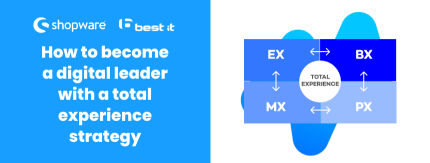
Our partner best it explains what Total Experience is and shows you various UX research methods that will help you achieve a long-term competitive advantage.
Total Experience is a strategy that aims to create a comprehensive experience for everyone who engages with a brand, from employees to customers, partners, and users. All contact points with the brand are improved, which simultaneously increases company growth.
Total Experience combines the following four disciplines under one roof:
Employee Experience (EX): All of an employee's experiences during their work with a company or organization.
Brand Experience (BX): Perception of the brand, and how the customer interacts with it.
Multi-Experience (MX): The entire experience with the brand across various channels, on various devices, and with various interaction modalities such as voice, touch, and gestures.
Product Experience (PX): The user's experience with a product, offering, or service.

Many companies have a hard time bringing these four disciplines together: The diversification of individual specialist departments' needs confronts them with major challenges. A specialized ecommerce department often represents the only interface between other departments such as procurement, marketing, and sales, as well as production and IT. Frequently a company's sole service department implements the ecommerce requirements of the specialist department – depending on the urgency.
In the process, the various priorities are often unclear and inconsistent, or there is a failure to focus on how the channels interact and on the relevance of customer communication across all channels and departments.
The strategic integration of UX research methods is crucial, and contributes to a successful Total Experience.
The best UX research methods to improve the Total Experience
In this blog, we look at the four disciplines (EX, BX, MX, and PX) from the UX research point of view.
Employee Experience
There is no longer any doubt that employee and customer experiences are directly correlated. Statistics on employee experience and customer experience demonstrate that companies leading in customer experience have 60 percent more engaged employees on average. In addition, studies by Blake Morgan, Customer Experience Futuristand bestselling author, show that investments in the employee experience not only influence the customer experience, but that they can above all generate a high ROI for the company.
Unfortunately, companies rarely consider their own employees' experiences – though employees in specialist departments could provide valuable input into optimization of the Total Experience.
For instance, customer service employees have deep understanding of users' pain points since they engage in an intensive exchange with them on problem situations. Other departments have similar insights. In addition, interviews with product management quickly indicate the challenges presented by product data management, and the extent to which processes and systems must be restructured to enable better-integrated product presentation in online or physical stores.
Yet all this information is rarely evaluated or shared with other departments and placed in a holistic context along the complete
customer journey.
Tips:
Stakeholder interviews with relevant departments guarantee that technology requirements and user interfaces are also taken into consideration. Workshops are carried out with all relevant departments to identify requirements, requests, and pain points in connection with the user's shopping experience.
Furthermore, employees in individual departments are encouraged to communicate their own needs and requirements. Customer service can suggest intelligent ways for you to use chatbots, FAQs, or download centers to reduce response times and increase customer satisfaction through fast service.
This would allow product management or the marketing department to work more efficiently since it req
uires improved access to customer data through optimal integration of the shop system, CRM, the newsletter system, and POS data.
During evaluation of the stakeholder interviews, the departments' needs are prioritized based on company goals and the Total Experience Strategy. Subsequent roadmap planning ensures that the defined goals are reached.

Brand Experience
As mentioned earlier, brand experience involves perception of the brand and how the customer interacts with it. What counts is the overall experience, all encounters that the customer has with the various brand touchpoints.
Today, brand awareness is a clearly measurable parameter that no longer necessarily requires comprehensive, cost-intensive market research. Various tools can be used to quickly and easily analyze brand mentions; these provide an overview of individual channels' or campaigns' performance indicators.
Media penetration and marketing activities can thus be easily measured. In particular, this creates a good impression of brand awareness outside the existing customer base and in comparison with competitors. These insights can be used to define new target groups and improve communication with existing target groups.
Qualitative UX research methods can also be employed when a brand image is being revised or expanded.
Tips:
On-site interviews can be used to determine consumers' initial impression of the brand. They can be questioned about their associations with the brand as well as the visual impression of the design. The questions are simple and clearly formulated, and allow the customer to answer both positively and negatively. The interviews are augmented with additional metrics such as the net promoter score (NPS) or the customer satisfaction score (CSAT), both of which make it possible to obtain clear data on the perception of the brand.

Focus groups can be used to present a picture of an opinion within a group. They show what potential customers think of the brand, and what its strengths and weaknesses are compared to competitors. With minimal effort, focus groups identify fields of action that can ultimately be used to improve brand awareness.
Marketing campaigns should follow a cross-medial approach if possible, since this is the only way to really measure the success of campaigns in the long run. Offline campaign data can be supplemented with user data from landing pages or transfers to digital channels and the corresponding web analyses. This provides you with a much better overview of the target groups you have reached, as well as the conversion rate within the digital channels.
Multi-Experience
Customers move on various platforms on their path along the customer journey, from the awareness phase to the advocacy phase. As they do, they frequently switch back and forth between media. However, many UX research methods are still used only to provide the most immediate user experience for a single channel. And this channel is often the online store.
Multi-experience goes far beyond thinking in channels and will become increasingly important in the future. As users, we are accustomed to communicating with numerous applications via many digital touchpoints (websites, social media, newsletters, apps, etc.)
Yet this means companies must shift their focus from canals to experience management.
MediaShop, for example, provides interaction with the brand and the same consistent customer experience on every device, whether on direct response TV or in the web store.

In order to create experiences such as in MediaShop, we must understand how people use a particular application, and how they interact with the company through it. Customers ultimately don't care which channel they're using. They just care about the optimal experience, tailored to their context, their touchpoints, and their interaction.
If we expand the contact points beyond the digital context, the company's image in the offline world also becomes relevant. Here too, it's important to avoid media discontinuities – for example, between the POS and the online store – and to provide the customer with a uniform brand experience. POS experiences can also be transferred to the digital channels.
Tips:
The entire customer journey can be examined, and pain points identified, using qualitative UX research methods such as shadowing, diary studies and user interviews. With all these methods, the focus is on the user's experience and not on the product or service.
With shadowing, the user is accompanied through their daily life for a short or longer period of time and their interaction with a product or service is observed. This reveals disruptive factors, which enables the product or service to be adapted to the user's environment.
A diary study is a UX research method in which participants record their thoughts, experiences and activities over a defined time period, normally a few days to several weeks. This is useful to better understand processes or the user's behavior, attitudes, and feelings.
Customer relationships and demands change over time. For this reason, UX research always considers the entire customer lifecycle; it is not just carried out once, but is established as a recurring component of optimization work.
Product Experience
With new services, and particularly with new products in unfamiliar markets as well as product innovations in existing markets, familiarity with the target group and its demands and expectations is crucial. To identify this need, markets and trends from the competitive environment are analyzed using UX research methods.
Please keep in mind that this is not true only for digital products. The aesthetics, design, user-friendliness, and user expectations for haptic product prototypes can also be tested in the course of user research.
This is also true for intuitive user interfaces: If these are taken into consideration during product development, costs are reduced sustainably, so that there may be no need for customer support in the future.
Tips:
Qualitative user research in the form of in-depth interviews, focus groups or prototype usability tests helps you quickly identify user problems and needs and verify appropriate hypotheses. When you use these methods, your development efforts focus only on a product's real success drivers. This means resources can be used cost-effectively, sustainably, and more specifically.
Plan UX research as a fixed component of your strategic annual plan. We'd be glad to help you plan – because when you have better insight into market and consumer needs, you can steer investments in new products, channel-specific optimizations, and expansions much more cost-efficiently, and with the highest ROI.
Thus, you have the four components that comprise your Total Experience strategy:

About the Author: best it
best it is one of the largest owner-operated customer experience agencies in Germany and Austria. We have successfully contributed to the digitalization of commerce for more than 22 years.
Passionate about growth, we create data-driven customer experiences that put the focus on your customers. More than 100 enthusiastic specialists link strategies, data, technology, and UX designs along the entire customer journey to future-oriented architecture.
The best it team would be glad to support you with the following services:
Strategy & consulting
User research, user experience, and user interface design
Development & operations
Solution architecture & system integration










